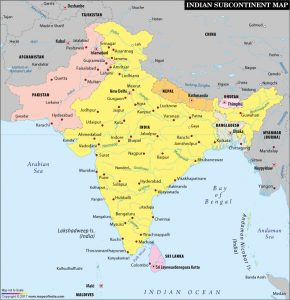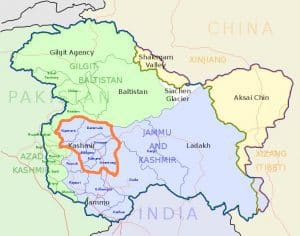During the Cold War, Pakistan was a key US ally. It helped the Reagan administration arm the Taliban to drive the Russians out of Afghanistan. Pakistan is still supporting the Taliban because it fears India’s domination of Afghanistan, which the US is encouraging. What to do about Pakistan? A better US policy would be to provide incentives to encourage Indian-Pakistan trust through joint infrastructure development and bilateral and regional trade.
Recently, President Trump famously denounced Pakistan via Twitter, threatened to cut off military aid to it, and then did just that.
President Obama’s former ambassador to Pakistan claims that the public way the President handled the rebuke and aid cutoff was unhelpful:
[T]he Trump administration’s attempt at humiliating and penalizing Pakistan is unlikely to work. Pakistan, like most countries, reacts very badly to public attempts to force its hand. It is likely to respond by showing how it can truly undercut our position in Afghanistan.
A better approach would be to privately convey, at the highest levels and without equivocation that the only way to preserve any relationship with the United States is to cut all ties with the Taliban, including the Haqqanis. The Trump administration, with its hard-line reputation and willingness to reject all previous United States policy, could credibly deliver this message.
But the ambassador’s recommendation that the U.S. “bring peace to Afghanistan by opening talks with the Taliban” strikes us as a Hail Mary toss.
Pakistan’s India problem

Georgraphy shows why Pakistan fears a two-front war with India and an Indian-dominated Afghanistan. Trump administration policy is mistakenly heightening those fears.
The problem that neither the former Obama ambassador nor the present Trump administration take up is Pakistan’s India problem. Pakistan supports the Taliban in Afghanistan to preserve Pakistani influence there, lest its arch enemy India comes to dominate Afghanistan. If that were to become a reality, militarily weak Pakistan would face a more powerful India not just on one front (the Punjab) but also a second, northern Afghan front.
What has the Trump administration done to help alleviate Pakistan’s valid defense concerns? It has called for India to intervene in Afghanistan to support it and buoy up its economy! Not surprisingly, Pakistan has taken the two predictable steps of increasing support for the anti-Indian jihadist groups it controls, including the Afghan Taliban, and allying with China.
A more sensible approach for the US to take would be to shift its aid away from the over-powerful intelligence-military sector and instead route it to well-managed civilian infrastructure projects, especially those intended to foster increased Pakistan-Indian trade.
The US’s China and Islamist problem
China has been offering to massively fund Pakistani infrastructure projects as part of its imperial “One Belt One Road” initiative, but with loan terms so onerous that even Pakistan has balked on some of the projects. China’s projects would strengthen China’s domination of Pakistan and use of Pakistan to give it harbor access to the Arabian Sea.

Imran Khan, supported by Pakistan’s Deep State, leads the pro-Chinese, anti-US Islamist opposition to the present Pakistani government
A further drawback of the President’s loud public rebuke of Pakistan and aid cutoff is that it is strengthening the Islamist, anti-US, army-and-intelligence-backed opposition to Pakistan’s present embattled civilian government –with important elections coming up in March (Senate) and July (National Assembly).
The US should be doing everything in its power to reduce Indian-Pakistani tensions. India is clearly going to become a key US ally in its Asian power-balancing efforts to contain China. While it’s unlikely that, given this imperative for the US, Pakistan will want to ally with the US, it should be helped to have at least a working relation with the US and India so that it preserves its national independence and doesn’t fall into complete Chinese dependency.
This means the US should provide encouragement and incentives to Pakistan to rejoin the South Asian Association for Regional Cooperation (SAARC) that it has been boycotting for some years now. The member states of SAARC are Bangladesh, Bhutan, Nepal, the Maldives, Sri Lanka, India, and Pakistan. This is a regional trade association that was intended to reap the gains from expanded trade that NAFTA and the European Union have enjoyed.
Pakistan has the second biggest economy among SAARC member states, and its non-participation as a counterweight to Indian domination has had the effect of scaring off the smaller countries from participating, out of fear of being overwhelmed by India. This in turn has motivated India to turn away from SAARC and place its trade hopes on the Bay of Bengal Initiative for Multi Sectorial Technical and Economic Cooperation (BIMSTEC), whose members are Bangladesh, Bhutan, India, Myanmar, Sri Lanka, Thailand, and Nepal. It has also concluded a number of productive bilateral trade deals with countries in its neighborhood — but not Pakistan.
Casus belli: the Kashmir Valley

The Kashmir Valley (small area within pink circle) is 95% Muslim and opposed to its Indian rulers.
The casus belli between the two countries has a name: the Kashmir Valley, which is 95% Muslim, adjacent to Pakistan, and ruled by India but not at all happy to be so ruled. Pakistan insists that peace and trade with India can only come about when India allows the Kashmir Valley the plebiscite that Indian leaders promised would take place after the post-WWII partition of the subcontinent into two countries. India says the reverse: progress toward resolving hostilities over the Kashmir and the Line of Control is only likely to come about after a period of peace and trade cooperation.
The US can’t broker an India-Pakistani settlement of the Kashmir. As with Israel and the Palestinians, that’s for the two antagonists to settle between themselves. But the US could and should encourage bilateral and regional trade cooperation in the hope that it will foster increased trust. It can do this by offering preferential trade arrangements with the US as part of an Indian-Pakistani bilateral or SAARC trade agreement that Pakistan fully participates in. It can also fund transportation and communication infrastructure joining the two countries.
Such a policy approach to Pakistan would help boost its moderates and slow China’s expansion to the south.

Leave a Reply